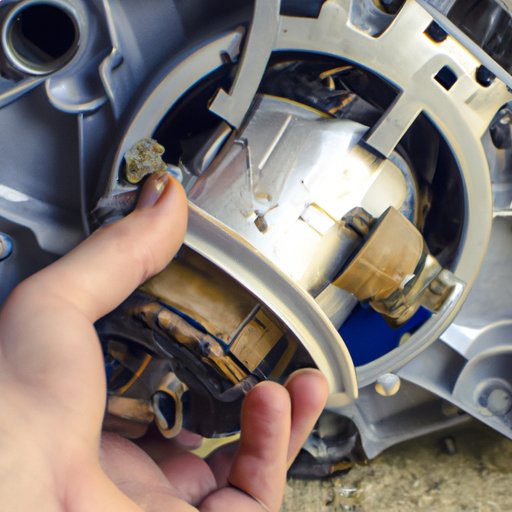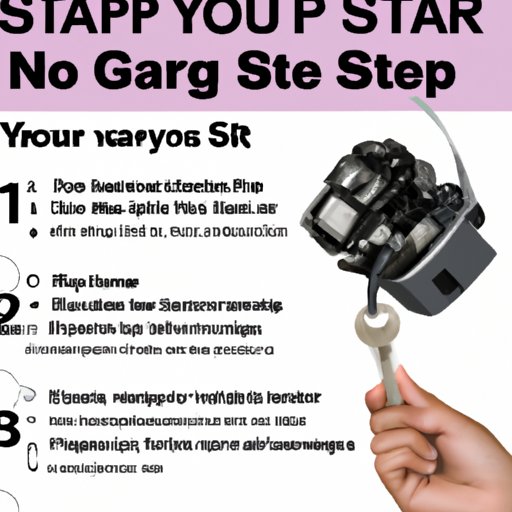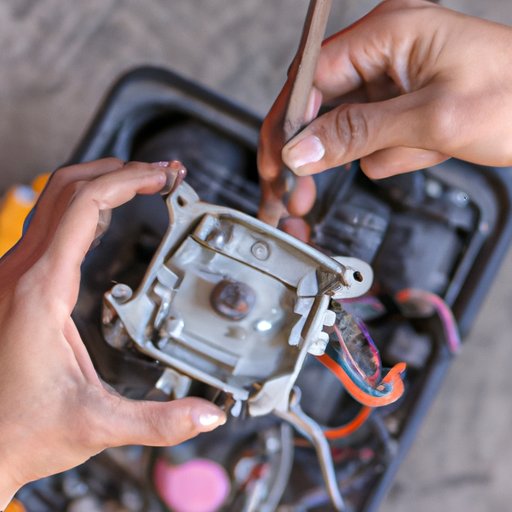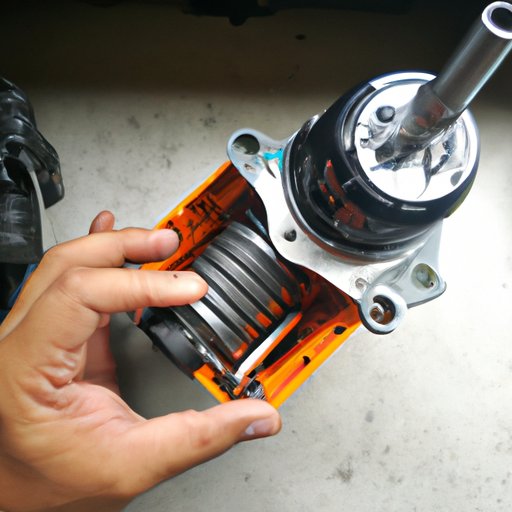Introduction
Car starters are an essential part of a car’s engine. They help turn the engine over so that it can start running. If your car isn’t starting, it could be due to a failing starter. In this article, we’ll explore how to change a car starter and provide step-by-step instructions, a video tutorial, and expert advice.
What is a Car Starter and Why Do You Need to Change It?
A car starter is an electric motor that helps turn the engine over when you turn the key in the ignition. It’s located between the battery and the engine and is responsible for spinning the flywheel, which then starts the engine. Over time, the starter can wear out and stop working, which is why it’s important to know how to change a car starter if necessary.
Benefits of Knowing How to Change a Car Starter
Knowing how to change a car starter can save you time and money. Instead of having to take your vehicle to a mechanic, you can replace the starter yourself. This can save you hundreds of dollars in labor costs, as well as the hassle of having to leave your car at the shop. Additionally, it can help you become more confident in your own automotive skills.
Step-by-Step Guide: How to Change a Car Starter
Changing a car starter is a complex process that requires special tools and knowledge. Before attempting to change a starter, make sure you have the necessary tools and supplies, as well as access to a service manual or an online resource with detailed instructions. Once you have everything you need, follow these steps to replace your car’s starter.
Necessary Tools
Before beginning any work on your car’s starter, you’ll need to gather the necessary tools and supplies. This includes a set of wrenches, a socket set, pliers, wire cutters, a screwdriver, and a power drill. You’ll also need a new starter, some electrical tape, anti-seize lubricant, and a few rags.
Preparing the Vehicle
Once you have all the necessary tools and supplies, you can begin preparing the vehicle for the starter replacement. Start by disconnecting the negative cable from the battery and then raising the vehicle up so that you have easy access to the starter. You may also need to remove other components such as the air intake and exhaust system.
Removing the Old Starter
Now that you have access to the starter, you can begin the removal process. Start by removing the mounting bolts and then disconnecting the electrical connections. Once the starter is free, you can carefully remove it from the vehicle.
Installing the New Starter
The next step is to install the new starter. Begin by lubricating the mounting bolts with anti-seize lubricant, then attach the starter to the engine block. Make sure all the bolts are securely tightened and then reconnect the electrical connections. Finally, reattach the negative cable to the battery and you’re good to go.
Video Tutorial: Replacing Your Car’s Starter
If you’re looking for a visual guide on how to change a car starter, check out this helpful video tutorial. This video will walk you through the entire process, from gathering the necessary tools and supplies to installing the new starter.
Link to Video
https://www.youtube.com/watch?v=ssH4XFxljKU
Tips from the Video
- Be sure to disconnect the battery before working on the starter.
- Make sure all bolts are securely tightened.
- Use anti-seize lubricant on the mounting bolts.
- Take extra care when working under your vehicle.
DIY Guide: Swapping Out Your Vehicle’s Starter
If you’re looking for a more comprehensive guide on how to change a car starter, this DIY guide is the way to go. This guide will walk you through every step of the process, from gathering the necessary parts and tools to troubleshooting common problems.
Gathering the Required Parts and Tools
The first step in changing a car starter is gathering the necessary parts and tools. This includes a new starter, a set of wrenches, a socket set, pliers, wire cutters, a screwdriver, and a power drill. You’ll also need some electrical tape, anti-seize lubricant, and a few rags.
Preparation Steps
Once you have all the necessary tools and supplies, you can begin preparing the vehicle for the starter replacement. Start by disconnecting the negative cable from the battery and then raising the vehicle up so that you have easy access to the starter. You may also need to remove other components such as the air intake and exhaust system.
Removing the Old Starter
Now that you have access to the starter, you can begin the removal process. Start by removing the mounting bolts and then disconnecting the electrical connections. Once the starter is free, you can carefully remove it from the vehicle.
Installing the New Starter
The next step is to install the new starter. Begin by lubricating the mounting bolts with anti-seize lubricant, then attach the starter to the engine block. Make sure all the bolts are securely tightened and then reconnect the electrical connections. Finally, reattach the negative cable to the battery and you’re good to go.

Troubleshooting Guide: Diagnosing and Replacing a Failing Starter
If your car’s starter is not functioning properly, you may need to diagnose and replace it. This guide will help you troubleshoot common issues and provide step-by-step instructions for replacing a failing starter.
Common Signs of a Faulty Starter
There are several signs that indicate a faulty starter. These include grinding or clicking noises when you turn the key in the ignition, slow or no cranking of the engine, or a burning smell coming from the engine bay. If you notice any of these signs, it’s time to investigate further.
Testing Your Vehicle’s Starter
To test your vehicle’s starter, you’ll need to connect a voltmeter to the starter solenoid. If the voltage reading is too low, it indicates that the starter is failing and needs to be replaced. You can also use a multimeter to check the continuity of the starter motor, which will tell you whether the motor is receiving power.
Replacing a Failing Starter
If the tests confirm that your starter is failing, you’ll need to replace it. Follow the same steps outlined above to remove the old starter and install the new one. Be sure to check the voltage readings after installation to ensure that the new starter is functioning properly.

Safety Tips for Changing a Car Starter
When changing a car starter, it’s important to take certain safety precautions. Here are a few tips to keep in mind:
Working with Automotive Fluids
When working with automotive fluids, such as oil or coolant, it’s important to wear gloves and protective eyewear. Additionally, make sure to contain any spills with absorbent materials and dispose of them properly.
Taking Care When Working Under Your Vehicle
When working under your vehicle, be sure to use jack stands and other supports to keep it stable. Never rely on a jack alone, as it can slip and cause serious injury. Additionally, always use wheel chocks to prevent the vehicle from rolling.
Wearing Appropriate Safety Gear
Whenever working on a vehicle, it’s important to wear appropriate safety gear. This includes protective eyewear, gloves, and sturdy footwear. Additionally, you should avoid wearing loose clothing or jewelry that could get caught in moving parts.

Common Problems with Car Starters and How to Fix Them
In addition to replacing a failing starter, there are a few other common problems that can occur. Here are a few of the most common starter problems and how to fix them.
Jumpstarting a Vehicle
If your vehicle won’t start, it could be due to a weak or dead battery. To jumpstart the vehicle, you’ll need to connect jumper cables to both the battery and the starter. Once connected, start the vehicle and let it run for a few minutes to charge the battery.
Starter Solenoid Issues
If the solenoid is faulty, it can prevent the starter from engaging. To test the solenoid, connect a voltmeter to the starter terminal. If the voltage reading is too low, it indicates a faulty solenoid and you’ll need to replace it.
Ignition Switch Issues
Another common issue is a faulty ignition switch. This can prevent the starter from turning over. To test the switch, check for voltage at the starter terminal when the key is turned. If there is no voltage, it indicates a faulty switch and you’ll need to replace it.
Expert Advice: How to Change a Car Starter in Minutes
If you’re looking for expert advice on how to change a car starter, here are a few tips from an experienced auto mechanic. First, make sure you have all the necessary tools and supplies beforehand. Next, take your time and follow each step carefully. Finally, read through the service manual or watch a video tutorial to ensure that you understand the process.
Tips From an Experienced Auto Mechanic
- Gather the necessary tools and supplies before beginning.
- Take your time and follow each step carefully.
- Read through the service manual or watch a video tutorial.
- Wear appropriate safety gear when working on your vehicle.
Further Resources for Learning More
If you’re looking to learn more about changing a car starter, there are plenty of resources available. You can find service manuals and video tutorials online, as well as forums where you can ask questions and get advice from experienced mechanics. Additionally, there are books and magazines devoted to car repair and maintenance.
Conclusion
Changing a car starter is a complex process that requires special tools and knowledge. In this article, we’ve explored how to change a car starter, providing step-by-step instructions, a video tutorial, and expert advice. We’ve also discussed safety tips, common problems, and troubleshooting techniques. With the right tools and knowledge, you can confidently change your car’s starter in no time.
(Note: Is this article not meeting your expectations? Do you have knowledge or insights to share? Unlock new opportunities and expand your reach by joining our authors team. Click Registration to join us and share your expertise with our readers.)
